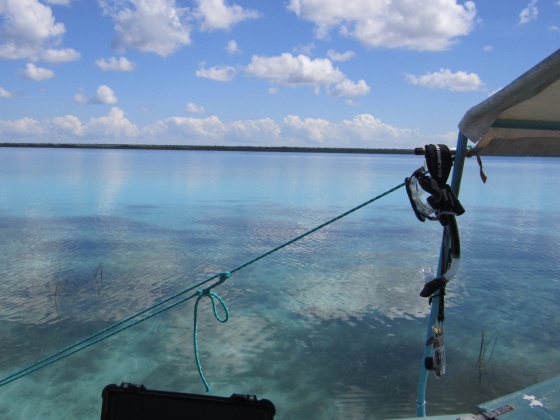Stromatolite Research and Conservation in Mexico's Laguna Bacalar
My Travel Story
This lake is also arguably among the most unique freshwater bodies worldwide, as it harbors living stromatolites, or colonies of microbes that precipitate rock and form large dome-like structures, which are found in only a few other locations. Scientists recognize these as one of the first life-forms to appear on Earth (~3.5 Billion years ago), and the largest living examples can be found Laguna Bacalar. Although its waters are fresh, the lake’s connectivity to the Caribbean has allowed many traditionally marine organisms to adapt and flourish there, including skate, bonefish, tarpon, and mangroves. The “Black-Striped mussel” (a cousin to the infamous Zebra mussel that invaded the American Great Lakes) has also taken up residence. These animals feed plankton, which currently exists only at low levels in Laguna Bacalar, keeping their populations in check. A significant increase in commercial development however, would introduce large amounts of nutrients to the water (from fertilizer, wastewater, etc.), providing a huge food source for plankton, causing their population to explode, thus fueling the mussel population to do the same. Stromatolites, which need to keep their surfaces open in order to photosynthesize and grow, would be unable to survive if blanketed with mussels. Simply put, more commercial tourism (e.g., golf courses, mega-resorts) equals more mussels, and the eventual extinction of the stromatolites. I realize this may be a lot to take in in a paragraph!
Again, this system was really only recently discovered by the scientific community. Only two scientific publications exist acknowledging the presence of stromatolites, and both were written within the last decade. I became aware of this place and its situation when I travelled there in 2012 as part of a college course trip. I and the professor of the course (now my boss) have continued to communicate with several local people including a biology teacher, who is working to promote education about the significance of the ecological treasure in their backyards. Only within the last decade, we’ve been told, people in local communities became aware that the “rocks” that line many of their shorelines are actually extremely rare living features.
Any amount of funding to help with travel related expenses would be immensely beneficial at this point for myself and another University of Wisconsin-Milwaukee graduate student to do preliminary research. This could eventually lead to larger scientific grants for more in depth studies, and ultimately, provide rational for conservation in this world class lake.
The goals of the project I plan to undertake are:
1. Get accurate counts of mussels on stromatolites to estimate mussel population density
2. Measure current plankton and nutrient levels in the water
3. Continue working and communicating with local educators and members of government, working toward understanding and protecting this ecosystem as well as promoting ecologically responsible tourism
A much more long-term goal to is develop a permanent research station on Laguna Bacalar’s shores, where American students can do research side by side with local students and professionals. As a graduate student, and as someone who had the opportunity to study there as an undergraduate, I have come to realize how invaluable an experience like that can be early in someone’s career.
Help keep Laguna Bacalar pristine, and promote scientific research and responsible tourism. Thank you for your donations!
More Travel Information
-
Campaign Ended
$ 0 USD
Total Donation Received-
0%
Funded -
$ 3,000 USD
Goal Amount -
0
Days Left
-
-
Cost Calculator
-
Local Travel Expenses
$ 800
-
Accommodation
$ 700
-
Luggage and Equipment
$ 500
-
Airfare/ International Flights
$ 1,000
-

